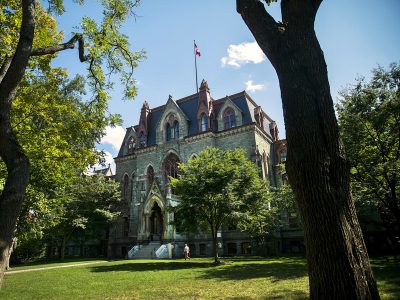Starting next September, Penn’s undergraduate residential system will undergo a major overhaul, one that will affect virtually every aspect of dormitory life. The dorms themselves will be transformed into 12 residential communities, known by the familar term “college houses,” which the authors of the recently-released 21st Century College House plan believe will integrate “students’ residential, intellectual, cultural, social, and recreational life at Penn.”
The plan — put together by the six-member Residential Communities Working Team, headed by Dr. David Brownlee, professor and graduate chair of the history of art department — is a major component of the 21st Century Project for the Undergraduate Experience. In the view of Dr. Stanley Chodorow, the provost, in fact, it is the project’s “crowning glory.”
The college houses “will create for undergraduates a smaller Penn out of the large, complex university that Penn is,” said Chodorow. “By doing that, the houses will make it easier for undergraduates to take advantage of that large, complex academy.” Chodorow and John Fry, Penn’s executive vice president, had charged the team with creating an implementation plan based on a previous committee’s “Choosing Community” report and a housing-redevelopment plan put together by the consulting firm of Biddison Hier.
In Brownlee’s view, the plan will expand and improve on the current system to “provide students — and the faculty and graduate students who live with them — support for the development of academic and co-curricular programming wherever they may live.”
Some of the 12 college houses, such as DuBois and Van Pelt, are already in existence, while others will be created from the high-rise dormitories (each will have one house) and the Quad (which will be divided into four). The traditional segregation-by-class arrangement will be replaced with a system in which each house will have freshmen, sophomores, juniors, and seniors. The plan will also bring into all residences the 21st Century Wheel Project, which provides beefed-up academic-support programs in mathematics, writing, information technology, library research, and languages.
In addition, each house will have:
- “enhanced staffing,” including a faculty master, faculty fellows, a dean, and a student peer-support system that will include graduate associates and resident advisers;
- an area set aside for its residents within the campus dining halls;
- study centers that will include computer and seminar rooms, office spaces, and social and “multipurpose” facilities.
“Freedom of choice” is an important feature of the plan. Students are
allowed to select their own residential communities and move from one
college house to another, and there are no mandatory dining
requirements. But the authors expect that the “increased amenities and
heightened sense of community of the college houses will attract growing
numbers of students to multi-year residences on campus.” In addition,
students who move into off-campus housing or fraternities “will retain
their college-house affiliations and will be able to continue using
college-house services and programs.” As Brownlee put it: “We want to
support our students in forming and shaping their own communities.”
Activities at the houses, the authors note, will be “defined and
executed by the residents, offering undergraduates, graduates, and
faculty the opportunity to work collaboratively on academic and
non-academic projects of common interest, supported by a new
infrastructure of facilities and services.”
While the plan’s implementation next year will kick off a
multi-year campaign to refurbish Penn’s residential buildings, the
authors say that little construction will be needed to launch this
program, and that most of the projected increase in annual operating
costs will be paid for by “efficiencies derived from the restructuring
of Penn’s residential-service divisions.” A $70 program fee, already
paid by a majority of undergraduates, will be extended to all 12
residences.
In an editorial titled “A new way of life in residences,” The Daily Pennsylvanian
voiced concerns about the elimination of freshman housing, which it
called “an integral part of the college experience.” But on the whole,
the DP gave the plan a tentative “thumbs up,” saying: “With all
the new academic and social programs expected to be created in these
college houses, it will certainly be a marked improvement over living in
a dorm where you barely know your neighbor.”




